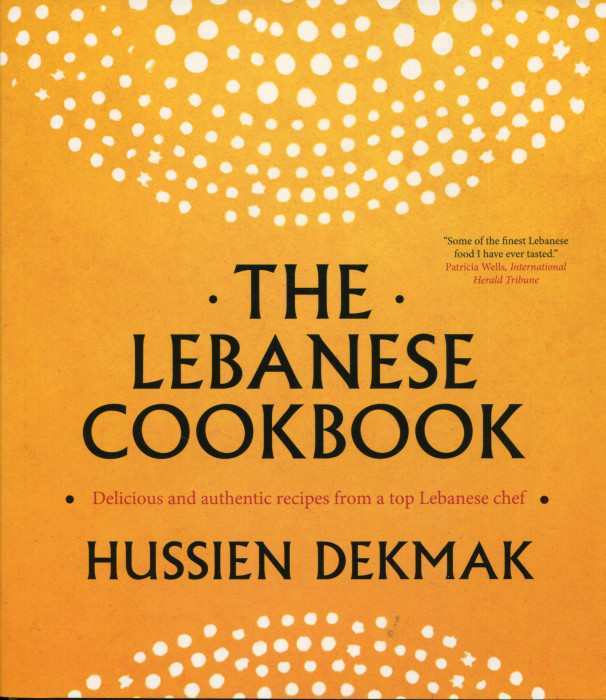It’s summer and time for the release of cookbooks that offer lighter, healthier dishes. And dishes that can be filled with surprise in just a matter of minutes.
The Lebanese Cookbook by Hussien Dekmak was just published and is a very welcome summer addition. Actually, it is a year round addition for Hussien’s one hundred recipes include the soups and heartier dishes enjoyed in a Lebanese winter. Yes, they have winter and mountains and special trees. More on that at the end. Let’s talk about food.
The term “fast food” has some negative connotations. A dash for lunch or a dinner brought home out of exhaustion. I understand. There are days when by 7PM all I could manage would be to wash some arugula and cut up a radish. That’s my limit.
Oh, wait. That’s a great salad from this book: Arugula Salad with Radishes. Here’s a picture:
Lebanon has a long history, some of that recent history tragic. Author Hussien Dekmak was born in Beirut but came to London where he learned to cook at the famed Al Hamra restaurant in London, a bastion of Lebanese cooking far from the shores of the Mediterranean. Today Hussein is the head chef for a chain of restaurants in London but retains all passion for the cuisine of Lebanon. That passion is on display in his recipes and in the beautiful photographs by Martin Brigdale.
The counterpoint to “fast food” is of course the Mediterranean diet. But many countries and climates and cultures flank the shores of that sea. Lebanon, with thousands of years of history, has evolved its own cuisine based on its particular climate and geography. The recipes are “simple” in that they often require few ingredients and not many steps — the ideal healthy dishes for busy Westerners. But these dishes resound in flavor because of the clever, almost intense, use of native ingredients: vegetables galore, olive oil from down the street, fish from the nearby sea, lamb and chicken and grains from the farms nestled at the foot of the mountains.
If you want a definition of “fresh and local” then Lebanese food is an icon, and that icon is on display in chapter after chapter in this book.
Soups include a simple Lentil with only butter, onion, and cumin added. From that that basic recipe there are extensions using Swiss chard, fried lamb, and bell peppers. There’s Chicken Soup with Vermicelli or, chicken cast aside, a Vegetable Soup with Vermicelli dense with carrot, zucchini, celery, and broccoli.
If any chapter in this book will capture your heart, it is the Salads, simple, direct, and visually stunning. There is that Arugula Salad with Radishes but also Potato Salad with tomato, bell peppers, parsley and mint. If you love olives, then why not just eat the Olive Salad with scallions, tomato, mint and bell pepper. [Yes, I’ll post the recipe and picture!]
Cold and Hot Appetizers are here, ranging from your own homemade yogurt or hummus to more elaborate fare. A Toasted Bread Salad includes carrot, romaine, tomatoes, radishes, scallion, bell pepper, garlic, parsley, and sumac. Not “fast, fast food” here but surely worth the time you’ll spend with your knife. Eggplant is here, of course: Stuffed and Pickled, in its own special Salad, and in a deep red Moussaka. A Humus with Lamb and Pine Nuts extends the “simple” humus into something more savory and satisfying.
Entrees here combine lamb, grains, eggplant, and spices to offer dishes that are both feisty and satisfying. For example Kofta with Eggplants and Tomato Sauce is baked lamb patties with deep fried eggplant all topped with a mixture of tomato paste and water. Grape leaves and zucchini appear here, stuffed with ground lamb and rice. There is a Chicken with Spinach main dish that adds clove, chickpeas, and pine nuts to offer a visual and taste treat. Finally, from the sea there is Lebanese Chile Fish featuring red snapper spiced up with cumin, cilantro, garlic, and chili pepper.
They Barbecue in Lebanon, so you can find ideas here for Shish Taouk, or broiled chicken breast piece on a skewers. There’s lamb chucks and ground lamb on skewers, too.
The Lebanese Cookbook concludes with a survey of authentic recipes for Doughs, Rice, Sauces, and Pickles. Pickled turnip intrigue you? And there are classic Desserts: Milk Pudding, Rice Pudding and an oddly named Vermicelli Dessert. Yes, vermicelli is part of a special pastry dough called osmalieh and layers of that dough are separated by a sweet cream sauce made with cream and toasted bread. It may sound a tad different but when you look at the picture on page 153, you’re going to be tempted.
That is, in fact, when I suggest you do. Pick up the book. The Lebanese Cookbook was just published in mid-May. You should be able to find copies in your local bookstore or you can always do the Amazon thing. Look at it, consider it. Had a busy day? Take home The Lebanese Cookbook, some arugula and some radishes. You can eat fast and well. Very, very well.
Oh, a side note about Lebanon, a small and often overlooked country. You thought Lebanon was always hot and deserty? No, in the winter it can almost freeze in Bruit and the mountains are adorned with snow. The foothills of those mountains were the home of the famed Cedars of Lebanon, cedar trees that ranged from Turkey into Syria and Lebanon. Prized for their wood and sap, the trees have been forested almost to extinction. In fact, deforestation was an issue addressed by Roman emperors. The trees were even purchased by Egyptian pharaohs, the wood for temples and ships, the resin for mummification. Today, there are extensive reforestation programs to bring back the beauty of these historic trees. Take a look at Wikipedia when you can:
https://en.wikipedia.org/wiki/Cedrus_libani
As I said, the food has a long pedigree.


